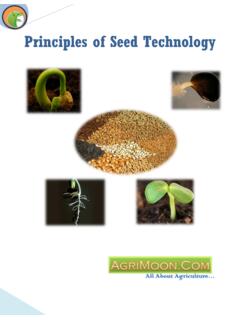Transcription of Heirloom Seeds Our Cultural Past - USDA
1 Heirloom Seeds Our Cultural Past Natural Resources Conservation Service Louisiana Many Field Office District Conservationist E. John Rogers 1st Revision October 24, 2011 American Indian Proud Have you ever wonder where your food comes from? Well thank the American Indians (North, Middle and South America)! Over 60% of all the food that the entire world eats today was originated and developed by American Indian people? It's true! A Sample of American Indian Food Contributions to the World Edible plants domesticated by Indians have become major staples in the diets of peoples all around the world. Some of the foods for example were corn ( maize ), wild rice, potatoes, sweet potatoes, peanuts, squashes and pumpkins, tomatoes, papayas, sunflower Seeds , avocados, pineapples, guavas, chili peppers, chocolate (cacao), and numerous species of beans. What are Heirloom Seeds ? It's said that a variety of Heirloom Seeds needs to be at least 50 years old to be considered an Heirloom .
2 A very old Heirloom is the 1500 Year Old Cave Bean found in a sealed clay pot in a cave in New Mexico, Thought to be left by the Anasazi Indians, this bean seed still germinated after all that time. Heirlooms vs. Hybrids The majority of Heirloom Seeds are open-pollinated, meaning that they reproduce themselves from seed. The plants from these Seeds grow true to that variety. When they are grown they will be the same as the parent plant. Hybrids are a cross between two varieties but, the Seeds from hybrids are either sterile or revert back to one of the original varieties. They won't be the same as the parent plant. Connection to Our Past Heirloom Seeds are grown today to keep people in touch with there ancestry. They offer a wide variety of sizes, tastes, colors and shapes, than the hybridized varieties bred to meet the needs of the commercial growers do. Saving the Past There are numerous tribes, as well as many non-profits, that are trying to recover Seeds and foods with American roots that American Indians relied upon for centuries On the Verge of Extinction Over the last quarter century, Native Seeds /SEARCH and the Seed Savers Exchange have rescued hundreds of varieties of Native American corn, beans and squash on the verge of extinction.
3 Maintaining Tradition The Zuni, Hopi, Iroquois Six Nations, and other tribes are now maintaining their own seed banks of their historical and Cultural plantings. Reasons for Saving American Indian Heirloom Seeds There are two good reasons why every American Indian Tribe should be reviving their Cultural food traditions. - First, the ceremonies, songs and stories of many tribes are linked to the planting and harvesting cycles of particular crops. - hybrid Seeds have no place in a tribes Cultural past. The Rise of Diabetes - Secondly, and even more importantly is that these foods are desperately needed by the many Native American communities due to diabetes, a disease unknown to American Indians born before 1900. The rise in diabetes on reservations and with people with American Indian heritage can be connected to the abandonment of traditional diets. - Nutritionists call these "slow release foods such as" - beans, cactus fruits, camas, acorns, mesquite and roasted mescal that are slowly digested and absorbed in ways that enhance insulin sensitivity.
4 Three Sisters In Native American lore corn was one of the "three sisters". Along with beans and squash, the three sisters were planted and grown together, supporting each other in their lifecycle and providing a very balanced diet of carbohydrates, proteins and vegetable fats to their cultivators. Corn stalks were support for climbing beans planted around them. Beans are legumes and fix atmospheric nitrogen (a necessary nutrient) into forms usable by the corn. The large leaves of the squash and its spreading vines shade the ground and help keep it cool and moist. Succotash Succotash is said to be one of the first recipes the Algonquin Indians taught the settlers at Plymouth Rock. If this is so, then the early versions was made without lima beans because they are a warm weather crop. Succotash was also made by the Narragansett Indians, who called it misckquitash , which means boiled corn . It is notable that the two primary ingredients are two of the Three Sisters beans, corn, squash the main agricultural crops of many Native American tribes.
5 Corn/ maize Domesticated along the Rio Balsas of Mexico about 2000 by Meso-Americans, corn is a staple food and has many ritual uses. Various kernel colors are selected for ceremonies and feast foods, and pollen is collected for ceremonial and medicinal purposes. Corn/ maize Facts Native American corn was the genetic foundation of all other corn varieties. -Columbus was one of the first Europeans to see maize or corn. -The Pueblo Indians were raising irrigated corn in the American Southwest when Coronado visited in 1540. -The settlers at Jamestown were taught how to raise it in 1608 and in 1620, it helped to keep the Pilgrims alive over winter. -Corn cobs were found in Tehucan, Mexico that date back 7000 years. Heirloom Corn Heirloom corns offer a wide choice of plant types, color and taste. Heirloom Corns, Popcorn's and Flour Corns include Black Mexican, Hopi Blue Flint, Hopi Yellow and Mandan Bride as well as others.
6 Native American Origins of Corn/ maize Many Native American traditions, stories and ceremonies surround corn. In New England there are many variations on how maize was brought or introduced to Native Americans here. Generally in southern New England, maize is described as a gift of Cautantowwit , a deity associated with the southwestern direction; that kernels of maize and beans were delivered by the crow, or in other versions the black-bird. Responsible for bringing maize , the crow would not be harmed even for damaging the cornfield. Other Algonquian legends recount maize was brought by a person sent from the Great Spirit as a gift of thanks. Corn and Culture Corn is important in ceremonial events, and various colored kernels are selected for ceremonies and feast foods. -Hopi blue Sakwapu, for instance, is ground to make ceremonial piki bread. -Hopi farmers plant plum-colored kernels of Hopi Greasy Hair "Wiekte," which matures early, so the harvest is ready for the Home Dance ceremony in July.
7 Native Americans and Corn New England tribes from the Mohegan in Connecticut to the Iroquois in the Great Lakes region had rituals and ceremonies of thanksgiving for the planting and harvesting of corn. One ceremony, the Green Corn ceremony of New England tribes, accompanies the fall harvest. Many tribes also had ceremonies for seed planting to ensure healthy crops as well as corn testing ceremonies once the crops were harvested. Heirloom Corn Varieties Following is a few varieties of American Indian Heirloom Black Aztec Corn Cherokee Long Ear Popcorn Hopi Blue Corn Bear Island Chippewa Flint Corn Hopi Pink Flour Corn Seneca Red Stalker Corn Mandan Bride Corn White Flint Corn Hominy Corn Oaxacan Green Corn Bear Island Chippewa Flint Corn A multi-colored flint corn with 8 to 12 rows of yellow, pink, white, red, blue and striped kernels.
8 A good grinding corn. Originally collected from the Chippewa in north-central Anasazi Sweet Corn The originally Seeds was obtained from a cave in New Mexico in a ceramic pot that had a lid and was sealed with pine pitch. The Seeds were later planted an after sprouting and growing out, the corn revealed itself as a currently unknown strain of multiple colors sweet corn. Black Aztec Corn Originally grown by the Aztecs 2,000 years ago, Black Aztec is a link with the past when it maintain a whole civilization. This corn is delicious and drought tolerant, The medium-sized ears have a sweet corn taste in the white or "milk" stage and the ears will then turn a deep jet black when fully mature for drying at which point it is ground for flour. 85 days. Cherokee Long Ear Popcorn Cherokee Long Ear corn is more than a decorative corn, it can be ground into cornmeal, eaten like sweet corn, or popped and used in soups. Because of its wide range of usage it is a highly prized Heirloom .
9 Cocopah Corn A rare Heirloom traced to the Colorado Mountain Indians in 1868. Sweet, fast growing with white kernels that turn shades of pink, blue, white and yellow when dry. Hopi Blue Corn At one time a traditional staple corn of the Hopi people. Hopi Blue grows 5-7' tall with purple/blue 9" ears. Can be eaten as sweet corn if picked young. Source of blue corn flour. Makes amazing blue tortilla chips. Hopi Pink Flour Corn The Heirloom Pink Flour Corn is one of the best flour corns that can be grown. It is drought tolerant, grows 5-6 feet high, and produces 8 ears with beautiful pink (with some white and red occasionally flecked in) kernels. 85-95 days. Wapsie Valley An old Indian corn variety. In the old days at corn shucking it was tradition for a young man to be able to kiss the girl of his choice if he found a red cob while shucking. A very extremely high protein corn. Seneca Red Stalker Corn Grown by the Seneca Indian Nation of Western New York.
10 Seneca Red Stalk is a highly ornamental corn with multicolor kernels and deep purple-red stalks and husks. Large 8"-9" ears; 100 days. Oaxacan Green Corn It has a smooth emerald green kernels on 6-10" ears. It has been grown for centuries by the Zapotec Indians of southern Mexico. They utilize it is to make green flour tamales. Drought resistant, 7' sturdy plants. Grown traditionally with squash and beans which climb up the corn stalks. 75-100 days. Mandan Bride Corn This corn originated with the Mandan Indians of Minnesota and North Dakota. Beautiful variegated coloration, including some striped kernels. In the past it was grown as a meal corn, today normally used as an ornamental. Ears are 6-8" long on 6' stalks. 85-90 days. White Flint Corn Heirloom White Flint Corn plays a very important role in the Oneida Tribes culture, and is even referenced in their Creation story. This was the corn that was brought to Valley Forge to feed George Washington s troops when the government could not get food or other supplies to their Army.













